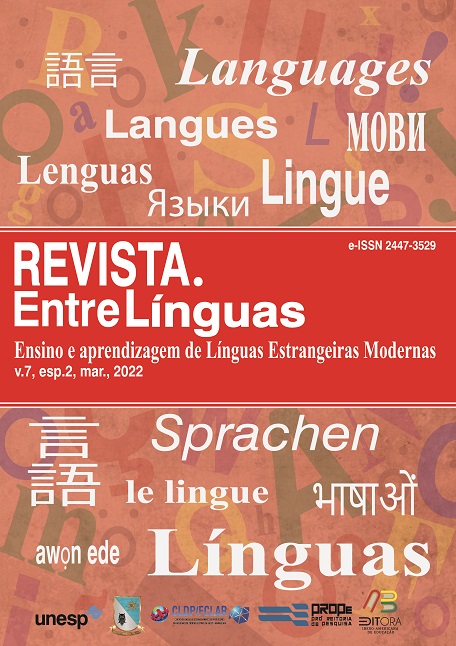Development of communicative competence in the process of learning the spanish language (experience in the use of musical material)
DOI:
https://doi.org/10.29051/el.v8iesp.2.17320Keywords:
Competencia comunicativa, Material musical, Aprendizaje del español, Conocimiento cultural, Interacción del habla, Pensamiento creativo, Enfoque comunicativo de la enseñanzaAbstract
The article discusses the problem of the development of communicative competence in the process of learning the Spanish language, taking as an example the use of musical material. In order to evaluate the use of the musical component as a tool for the development of the communicative competence of Spanish students at the Moscow Aviation Institute (MAI) (National Research University), a survey was conducted among 110 students from the Institute of Foreign Languages of the MAI. The data obtained during the survey indicate that the majority of students note the positive impact of the use of musical material in Spanish classes, which, first of all, accelerates its assimilation. Based on pedagogical experience, the authors present the experience of using songs in Spanish, and also describe task options on musical material that contribute to the development of students' communicative competence.
Downloads
References
ANDREEV, A. N. et al. The effectiveness of using visualization tools and forms in distance learning. Revista Tempos e Espaços em Educação, v. 14, n. 33, e16053, 2021. Available: https://seer.ufs.br/index.php/revtee/article/view/16053. Access: 13 June 2022.
ARTYUSHINA, G.; SHEYPAK, O. A. Mobile Phones Help Develop Listening Skills. Informatics, v. 5, n. 3, July 2018. Available: https://www.mdpi.com/320730. Access: 12 July 2022.
BESEDOVA, P.; STOCKOVA, K.; SOUKUPOVA, K. Using music in foreign language lessons. In: BEKIROGULLARI, Z.; MINAS, M. Y.; THAMBUSAMY, R. X. (ed.). ICEEPSY 2018: Education and Educational Psychology. Future Academy, 2019. Available: https://www.europeanproceedings.com/article/10.15405/epsbs.2019.01.43. Access: 16 Oct. 2021.
BESEDOVAA, P. Music as an intercultural medium of foreign language teaching. In: BEKIROGULLARI, Z.; MINAS, M. Y.; THAMBUSAMY, R. X. (ed.). ICEEPSY 2016: Education and Educational Psychology. Future Academy, 2019. Available: https://www.europeanproceedings.com/files/data/article/46/1359/article_46_1359_pdf_100.pdf. Access: 12 abr. 2022.
DENISOVA, D. A. et al. Formation of cognitive activity of technical university students using elements of blended learning in the study of quantum physics. Revista Tempos e Espaços em Educação, v. 14, n. 33, e15296, 2021. Available: https://seer.ufs.br/index.php/revtee/article/view/15296. Access: 24 June 2022.
KABAKOV, V. V.; AGUILAR-CRUZ, P. J. Implementation of manipulative speech tactics in translation (based on English and Spanish journalistic texts). Amazonia Investiga, v. 10, n. 38, p. 33-38, 2021. Available: https://amazoniainvestiga.info/index.php/amazonia/article/view/1540. Access: 10 jan. 2022.
KARABULATOVA, I. et al. The role of creative musical activity in learning foreign languages. Thinking Skills and Creativity, v. 41, Sept. 2021. Available: https://www.sciencedirect.com/science/article/pii/S1871187121001322. Access: 06 July 2022.
KARTUSHINA, N. V. Competence matrix of a foreign language teacher in higher education: Formal presentation. Thinking Skills and Creativity, v. 41, 100916, Sept. 2021. Available: https://www.sciencedirect.com/science/article/pii/S1871187121001310. Access: 15 June 2022.
KRIVOVA, A. L. et al. Social Networks as a Means of Monitoring Students’ Progress. Propósitos y Representaciones, v. 9, n. esp. 3, e1264, May 2021. Available: https://revistas.usil.edu.pe/index.php/pyr/article/view/1264. Access: 16 Feb. 2022.
KRYANEV, Y. V.; PAVLOVA, T. P.; KVON, D. A. Phenomenon of Education: Philosophical and Methodological Aspects of Research. Amazonia Investiga, v. 10, n. 39, p. 102-116, Mar. 2021. Available: https://dialnet.unirioja.es/servlet/articulo?codigo=7921293. Access: 10 June 2022.
NAGOVITSYN, R. S. et al. Creative Pedagogical Development of Students Based on the Implementation of Didactic Games. Revista Romaneasca Pentru Educatie Multidimensionala, v. 12, n. 4, p. 156-171, 2020. Available: https://www.lumenpublishing.com/journals/index.php/rrem/article/view/2891. Access: 09 Apr. 2022.
NEDOSUGOVA, A. B. et al. Ensinando guias de turista línguas estrangeiras: encontrando métodos eficazes. Revista EntreLinguas, Araraquara, v. 7, n. esp. 4, e021102, 2021. Available: https://periodicos.fclar.unesp.br/entrelinguas/article/view/15660. Access: 8 Dec. 2021.
TOLSTYKH, O.; KHOMUTOVA, A. Developing the communicative competence of the university teaching staff: An integrated-skill approach. General and Professional Education, v. 2, p. 38-43, 2012. Available: http://genproedu.com/paper/2012-02/038-043.pdf. Access: 10 Feb 2022.
UKHOV, P. et al. Problems of distance learning in the lms moodle environment through the eyes of students of Moscow Aviation Institute during quarantine (self-isolation). Revista Inclusiones, v. 7, n. 3, p. 412-426, July/Sept. 2020. Available: https://revistainclusiones.org/index.php/inclu/article/view/1644. Access: 10 de June 2022.
USMANOVA, Z. et al. Impact of computer-assisted translation tools by novice translators on the quality of written translations. Laplage em Revista, v. 7, p. 714-721, 2021. Available: https://www.researchgate.net/publication/353469289_Impact_of_computer-assisted_translation_tools_by_novice_translators_on_the_quality_of_written_translations. Access: 08 Jan. 2022.
ПАШКЕЕВА, И. Ю. Использование песен в обучении иностранному языку. Вестник Казанского технологического университета, v. 17, n. 5, p. 361–365, 2014.
САЛТЫКОВА, М. В. Проблема мотивации и роль музыки при обучении иностранному. языку. В сборнике: Инновации в современной науке. Материалы XI. Международного зимнего симпозиума. 2016. p. 77–79.
ТОМАШУК, Н. В. Использование музыки и песен в обучении иностранному языку наначальном этапе. Вызовы глобального мира. Вестник ИМТП, v. 1, n. 5, p. 117-123, 2015.
Published
How to Cite
Issue
Section
License

This work is licensed under a Creative Commons Attribution-NonCommercial-ShareAlike 4.0 International License.
Os manuscritos aceitos e publicados são de propriedade da Revista EntreLínguas. Os artigos publicados e as referências citadas na Revista EntreLínguas são de inteira responsabilidade de seus autores.
Transferência de direitos autorais – autorização para publicação
Caso o artigo submetido seja aprovado para publicação, já fica acordado que o(s) autor(es) autoriza(m) a UNESP a reproduzi-lo e publicá-lo na EntreLínguas, entendendo-se os termos “reprodução” e “publicação” conforme definição respectivamente dos incisos VI e I do artigo 5° da Lei 9610/98. O artigo poderá ser acessado pela rede mundial de computadores (Internet), sendo permitidas, a título gratuito, a consulta e a reprodução de exemplar do artigo para uso próprio de quem a consulta, desde que haja a citação ao texto consultado. Essa autorização de publicação 328 EntreLínguas, Araraquara, v. 1, n .2, p. 323-328, jul./dez. 2015 não tem limitação de tempo, ficando a UNESP responsável pela manutenção da identificação do(s) autor(es) do artigo. Os artigos publicados e as referências citadas na Revista EntreLínguas são de inteira responsabilidade de seus autores.











